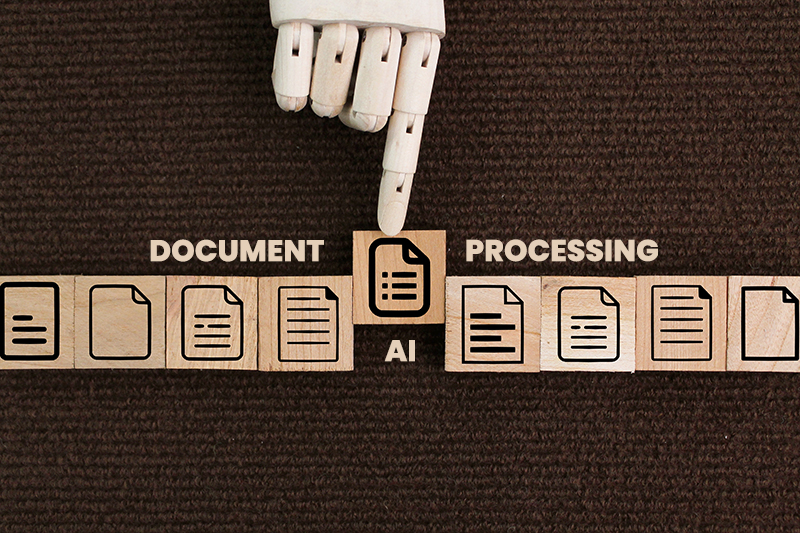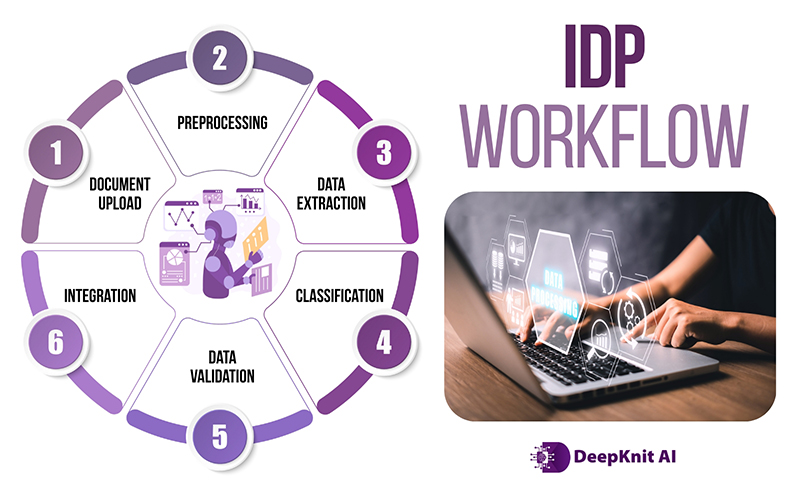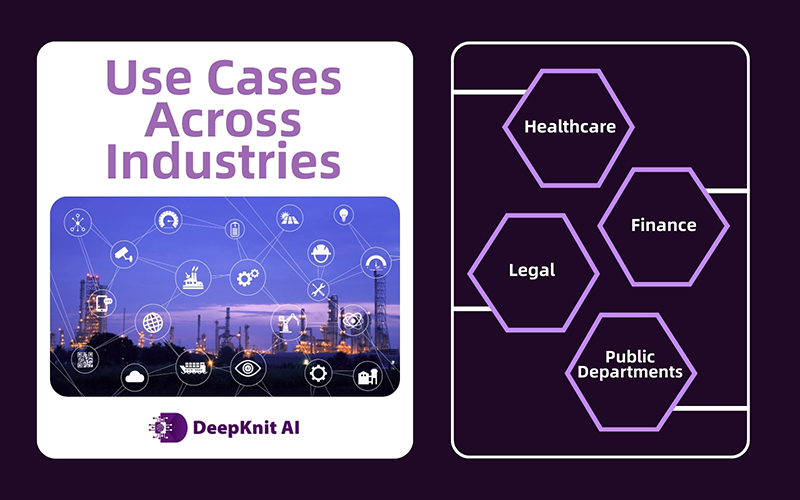Did you know that over 80% of business data is basically trapped in unstructured formats like emails, PDFs, scanned forms, and handwritten notes; left unused and most likely, left unused?
To put things into perspective, that’s almost an ocean of valuable information—but for organizations looking to make use of it, it’d be like finding that one, specific drop in that ocean, amidst a hurricane. Enter Intelligent Document Processing (IDP): the game-changing solution in AI-powered document automation that not only scans your documents, but actually understands the context, extracts what’s relevant, and makes the data instantly usable. And, what’s at the heart of modern IDP? Artificial Intelligence.
If you’ve ever wondered how IDP works, why it’s such a big deal these days, and where AI fits in—you’re in the right place. Let’s explore it.
What Is Intelligent Document Processing (IDP)?
As you might have already guessed, Intelligent Document Processing—at its core—is about turning documents of any format, any structure into actionable, structured data.
Consider it the next big step from the basic scanning capability of Optical Character Recognition (OCR). While OCR merely scans what it ‘sees’ in an image, IDP has the capability to interpret it in context.
An example of OCR versus Intelligent Document Processing:
- A traditional OCR tool might recognize that a scanned invoice says, “Total Due: $2,478.50” and extract/organize it and other related data.
- An IDP solution not only scans that number but also understands that it’s related to an invoice, thereby linking it to the correct customer account, and feeding it into your accounting system automatically.
That’s the difference between just digitizing documents and making them smart.
Intelligent Document Processing Workflow Explained
Before we figure out where AI fits in, we need to see how an IDP system processes a document from start to finish.
Here’s the IDP workflow:
- Document Upload
Documents come from various sources like emails, APIs, cloud drives, or physical computer systems. Generally, IDP solutions are designed to handle ingestions in mixed batches viz, invoices, forms, contracts—you name it.
- Preprocessing
Before the system extracts relevant data, it requires a clean and machine-readable version of the document. Preprocessing can involve:
- Noise removal from scanned images
- Aligning skewed pages
- Adjusting fonts and sizes
- Improving image clarity for OCR
- Data Extraction
This is the part of the process where the actual magic starts. The system leverages a combination of the following:
- OCR identifies printed or handwritten text
- Computer Vision classifies elements like logos, tables, or signatures
- Natural Language Processing (NLP) to interpret and segregate content
- Classification
The system figures out what kind of document is uploaded: Is it a sale invoice? A purchase order? A patient discharge summary? Through classification, it can be ensured that the extracted fields match the right template or extraction rules.
- Data Validation
There is no AI that is perfect right off the shelf. Therefore, validation layers with human oversight (human-in-the-loop review) check for accuracy, cross-reference extracted values with databases and promptly flag any anomalies.
- Integration
Finally, the clean, structured data is exported in any preferred format(s) to the required business systems: CRMs, ERPs, case management tools, or analytics dashboards.
How AI Enhances Intelligent Document Processing
If you strip away AI from IDP, it would just become a bunch of rigid rules and templates. It’d be fine for a ground-level document processing assignment until you deal with:
- Documents with differing layouts
- Industry-oriented jargon
- Handwritten notes
- Unstructured data
This is where AI turns IDP into a sensible system capable of doing much more than reading things as it is.
- AI in Data Recognition
Instead of having to rely solely on OCR, AI-powered IDP uses machine learning models to:- Understand handwriting with high accuracy
- Comprehend the context (e.g. differentiating between “date of birth” and “date of service”)
- Process multilingual documents without having to build separate templates
- AI in Document Classification
AI models learn from historical data to segregate documents based on language patterns, formatting, and content, even if the document does not match any pre-programmed template. - AI in Data Validation
AI can cross-reference extracted data against patterns and context. For example, if an invoice says “Total Due: $1,500” but line items only add up to $1,200, the system will flag it automatically and notify promptly as well. - AI in Continuous Learning
Modern IDP systems don’t just process documents but they improve over time. With every correction from a human reviewer, the AI learns from the mistakes, becomes smarter and reduces future errors.
IDP vs Traditional Document Processing
So, what is the difference between intelligent document processing and traditional document processing?
| Feature | Traditional/Manual OCR | Intelligent Document Processing |
|---|---|---|
| Layout Adaptability | Fixed templates required | Learns and adapts dynamically |
| Handwriting Recognition | Limited; prone to errors | High accuracy with AI models |
| Language Support | Single or a very few | Multi-language, context-aware |
| Data Integration | Manual export | Automated into systems |
| Accuracy | 70-80% | 95%+ (with learning) |
Use Cases Across Industries
The real beauty of IDP is that it’s industry-agnostic. Here are a few examples:
- Finance
- Automated invoice processing
- Loan document verification
- Fraud detection via anomaly checks
-
- Healthcare
- Patient intake form digitization
- EHR summarization
- Insurance claim automation
- Healthcare
(This is where DeepKnit AI stands out—with healthcare-focused IDP models capable of interpreting complex medical records and delivering clinician-ready summaries.)
- Legal
- Contract review and clause extraction
- Litigation document organization
- Compliance reporting
- Public Departments
- Processing census forms
- Digitizing public records
- Automating permit applications
Why AI-powered IDP Matters Now More Than Ever
Gartner predicts that by 2026, over 60% of organizations may adopt AI-based document processing to improve operational efficiency.
The shift is being driven by:
- Remote and hybrid work: More documents are created and shared digitally
- Compliance pressures: Automated audit trails are becoming non-negotiable
- Customer expectations: People expect faster turnaround times for services
Without AI, keeping up with this document tsunami would be almost impossible.
What the Challenges Are and How to Overcome Them
No technology is flawless. Common challenges in IDP include:
- Data privacy concerns: Especially in healthcare, finance, and government sectors
- Poor-quality scans: Garbage in, garbage out
- Varied/inconsistent data: Complex handwriting or unusual formats
Solutions
-
- Partnering with vendors that have industry-specific AI models (like DeepKnit AI in healthcare)
- Ensuring secure and compliant cloud services or on-premises deployment
- Embedding human-in-the-loop review for high-valued documents
What’s the Future of Intelligent Document Processing?
The domain of IDP is interesting and offers room for some creative updates. Expect to see:
-
-
- No-template IDP: Systems that require no predefined rules at all to process.
- Integrated analytics: Extracted data will be fed directly into AI-driven insights.
- Voice-to-document workflows: Speech recognition for easier document creation
- Multi-modal AI: Blending text, image, and even audio data understanding
-
Why Collaborate with DeepKnit AI for Smart IDP
If you are ready to take that quantum leap from basic OCR to absolute document intelligence, the right partner is what could make all the difference for your business.
DeepKnit AI is one of the pioneers in domain-focused IDP solutions, especially in industries where precision and compliance are non-negotiable factors.
Here’s what sets us apart:
-
-
- Domain-trained AI models for healthcare, legal, and compliance-heavy industries
- Seamless integration with your existing workflows and systems
- Scalable architecture to handle everything from pilot projects to enterprise-wide deployments
- Continuous learning so your IDP solution becomes smarter over time
-
Intelligent Document Processing is not just about saving time—it’s all about extracting that hidden value in your organization’s data goldmine. And with AI leading that surge ahead, the possibilities are absolutely limitless. It doesn’t matter if you’re dealing with invoices, medical records, contracts, or compliance reports, this transition to AI-powered IDP isn’t a question of “if,” but “when.”
When you’re ready to make that move, DeepKnit AI can help you get there; smarter, faster, and with the precision your industry demands.
Stop Reading. Start Knowing.
Let DeepKnit AI be your digital data excavator. We turn documents into decisions.
Contact Us



